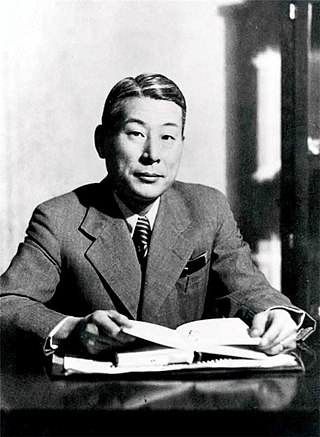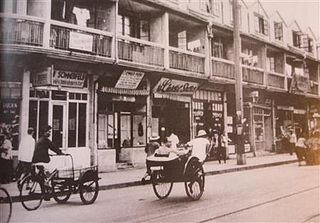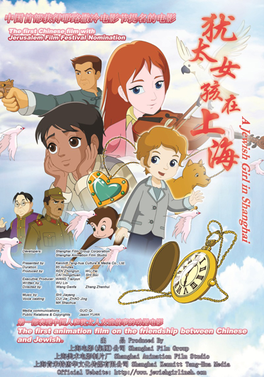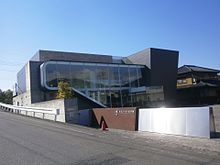
Chiune Sugihara was a Japanese diplomat who served as vice-consul for the Japanese Empire in Kaunas, Lithuania. During the Second World War, Sugihara helped thousands of Jews flee Europe by issuing transit visas to them so that they could travel through Japanese territory, risking his job and the lives of his family. The fleeing Jews were refugees from German-occupied Western Poland and Soviet-occupied Eastern Poland, as well as residents of Lithuania. In 1985, the State of Israel honored Sugihara as one of the Righteous Among the Nations for his actions. He is the only Japanese national to have been so honored. In Lithuania, 2020 was "The Year of Chiune Sugihara". It has been estimated as many as 100,000 people alive today are the descendants of the recipients of Sugihara visas.

During World War II, some individuals and groups helped Jews and others escape the Holocaust conducted by Nazi Germany.
Shortly prior to and during World War II, and coinciding with the Second Sino-Japanese War, tens of thousands of Jewish refugees were resettled in the Japanese Empire. The onset of the European war by Nazi Germany involved the lethal mass persecutions and genocide of Jews, later known as the Holocaust, resulting in thousands of Jewish refugees fleeing east. Most ended up in Japanese-occupied China.

Jan Zwartendijk was a Dutch businessman and diplomat. As director of the Philips factories in Lithuania and part-time acting consul of the Dutch government-in-exile, he supervised the writing of 2,345 visas for Curaçao to save Jews from the Holocaust during World War II. In 1997, Yad Vashem recognised him as Righteous Among the Nations.
Antisemitism in Japan has developed over the years despite the presence of a relatively small and obscure Jewish population. Japan had no traditional antisemitism until nationalist ideology and propaganda began to spread on the eve of World War II. Before and during the war, Nazi Germany, an ally to the Japanese, encouraged Japan to adopt antisemitic policies. In the post-war period, extremist groups and ideologues have promoted conspiracy theories.

Beginning with the invasion of Poland during World War II, the Nazi regime set up ghettos across German-occupied Eastern Europe in order to segregate and confine Jews, and sometimes Romani people, into small sections of towns and cities furthering their exploitation. In German documents, and signage at ghetto entrances, the Nazis usually referred to them as Jüdischer Wohnbezirk or Wohngebiet der Juden, both of which translate as the Jewish Quarter. There were several distinct types including open ghettos, closed ghettos, work, transit, and destruction ghettos, as defined by the Holocaust historians. In a number of cases, they were the place of Jewish underground resistance against the German occupation, known collectively as the ghetto uprisings.

In the decades since the Holocaust, some national governments, international bodies and world leaders have been criticized for their failure to take appropriate action to save the millions of European Jews, Roma, and other victims of the Holocaust. Critics say that such intervention, particularly by the Allied governments, might have saved substantial numbers of people and could have been accomplished without the diversion of significant resources from the war effort.

The Holocaust in Poland was the ghettoization, robbery, deportation, and murder of Jews in occupied Poland, organized by Nazi Germany. Three million Polish Jews were murdered, primarily at the Chelmno, Belzec, Sobibor, Treblinka, and Auschwitz II–Birkenau extermination camps, representing half of all Jews murdered during the Europe-wide Holocaust.

The Shanghai Ghetto, formally known as the Restricted Sector for Stateless Refugees, was an area of approximately one square mile in the Hongkew district of Japanese-occupied Shanghai. The area included the community around the Ohel Moshe Synagogue. Shanghai was notable for a long period as the only place in the world that unconditionally offered refuge for Jews escaping from the Nazis. After the Japanese occupied all of Shanghai in 1941, the Japanese army forced about 23,000 of the city's Jewish refugees to be restricted or relocated to the Shanghai Ghetto from 1941 to 1945 by the Proclamation Concerning Restriction of Residence and Business of Stateless Refugees. It was one of the poorest and most crowded areas of the city. Local Jewish families and American Jewish charities aided them with shelter, food, and clothing. The Japanese authorities increasingly stepped up restrictions, surrounded the ghetto with barbed wire, and the local Chinese residents, whose living conditions were often as bad, did not leave. By 21 August 1941, the Japanese government closed Shanghai to Jewish immigration.

During World War II, Lithuania was occupied by the Soviet Union (1940–1941), Nazi Germany (1941–1944), and the Soviet Union again in 1944. Resistance during this period took many forms. Significant parts of the resistance were formed by Polish and Soviet forces, some of which fought with Lithuanian collaborators. This article presents a summary of the organizations, persons and actions involved. Lithuania was de facto independent from June 24, 1941, until June 30, 1941, when Nazi Germany took full control of the area.

On three cases, entire countries resisted the deportation of their Jewish population during the Holocaust. In other countries, notable individuals or communities created resistance during the Holocaust which helped the Jews escape some concentration camps.
The history of the Jews in Kobe, Japan, is recorded from the 19th century onwards.

The Holocaust in Lithuania resulted in the near total destruction of Lithuanian (Litvaks) and Polish Jews, living in Generalbezirk Litauen of Reichskommissariat Ostland within the Nazi-controlled Lithuanian SSR. Out of approximately 208,000–210,000 Jews, an estimated 190,000–195,000 were murdered before the end of World War II, most of them between June and December 1941. More than 95% of Lithuania's Jewish population was massacred over the three-year German occupation – a more complete destruction than befell any other country affected by the Holocaust. Historians attribute this to the massive collaboration in the genocide by the non-Jewish local paramilitaries, though the reasons for this collaboration are still debated. The Holocaust resulted in the largest-ever loss of life in so short a period of time in the history of Lithuania.

Abraham Setsuzō Kotsuji was a Japanese Orientalist, and the son of a Shinto priest who descended from a long line of Shinto priests. During the Holocaust he helped Jewish refugees to escape the Nazis, arranging for them to stay first in Kobe and later in Japanese-occupied Shanghai. He also fought against Nazi-inspired anti-Jewish propaganda. A book about how he helped Jewish refugees was written by Japanese actor Jundai Yamada and published in April 2013 by NHK Shuppan.

The Holocaust in Belarus refers to the systematic extermination of Jews living in the Byelorussian Soviet Socialist Republic during its occupation by Nazi Germany in World War II. It is estimated that roughly 800,000 Belarusian Jews were murdered during the Holocaust. However, other estimates place the number of Jews killed between 500,000 and 550,000.

Josef Albert Meisinger, also known as the "Butcher of Warsaw", was an SS functionary in Nazi Germany. He held a position in the Gestapo and was a member of the Nazi Party. During the early phases of World War II Meisinger served as commander of Einsatzgruppe IV in Poland. From 1941 to 1945 he worked as liaison for the Gestapo at the German embassy in Tokyo. He was arrested in Japan in 1945, convicted of war crimes and was executed in Warsaw, Poland.

A Jewish Girl in Shanghai is a 2010 Chinese animated family film written by Wu Lin and based on his graphic novel of the same name. It is directed by Wang Genfa and Zhang Zhenhui, and voiced by Cui Jie, Zhao Jing and Ma Shaohua.

The history of the Jews in Japan is well documented in modern times, with various traditions relating to much earlier eras.

Persona Non Grata is a 2015 Japanese biographical drama film directed by Cellin Gluck. It depicts the life of Japanese diplomat Chiune Sugihara who was appointed a vice-consul and later a consul in Lithuania and served there from 1939 to 1940 and who saved lives of some 6,000 Jewish refugees by issuing transit visas to the Japanese Empire.

After the German invasion of Poland in World War II and the division of Poland between Germany and the Soviet Union, many yeshivas that had previously been part of Poland found themselves under Soviet communist rule, which did not tolerate religious institutions. The yeshivas therefore escaped to Vilnius in Lithuania on the advice of Rabbi Chaim Ozer Grodzinski. In Lithuania, the yeshivas were able to function fully for over a year and many of the students survived the Holocaust because of their taking refuge there, either because they managed to escape from there or because they were ultimately deported to other areas of Russia that the Nazis did not reach. Many students, however, did not manage to escape and were killed by the Nazis or their Lithuanian collaborators.
















